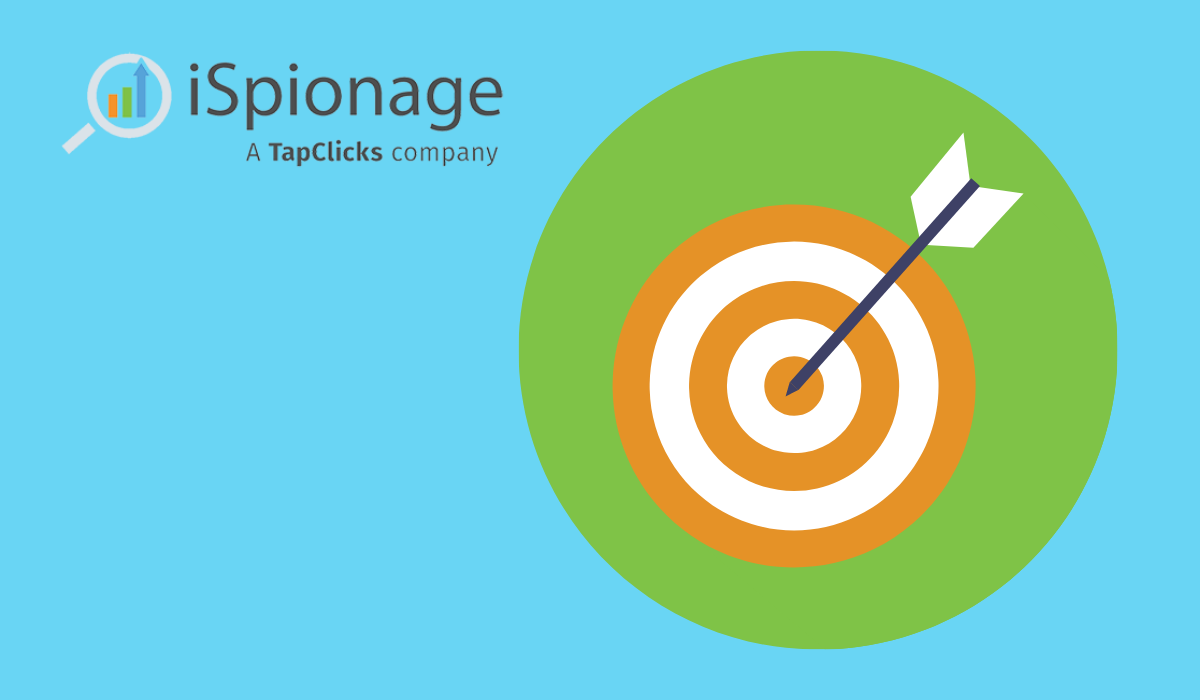
If you’re running PPC advertising on Google Ads (Google Adwords), lowering your cost-per-click (CPC) is likely to be a constant ambition. Naturally, efficient campaigns generate a better ROI, and this can maximize your profits or enable you to scale advertising efforts to new heights. So, rather than setting-and-forgetting your Google Ad campaigns, it’s vital to tweak your setup to achieve lower CPCs.
For expert insight about how to reduce CPCs, we spoke to Adam Dolan – marketing consultant and founder of First Spark Digital. He is a PPC expert, and has worked with startups and Fortune500 companies over the past decade to grow their businesses through paid search and paid social media.
In this article, we reveal Adam’s advice for getting a lower CPC, and show how you can apply insights from competitor analysis to improve PPC campaign performance and reduce your CPCs.
How to Lower Your CPC: 3 Key Strategies
There are plenty of theories about how to get a lower CPC, but according to Adam, relevance is the key ingredient. You will only reduce your CPC if you can match the user search intent throughout the funnel.
It is in Google’s own interest to optimize the user experience, and this is one way to ensure that you are rewarded for making it as positive and seamless as possible.
“In most cases, lowering your CPC starts with achieving alignment between your target keyword, ad copy, and landing page. And ultimately, if you can effectively match search intent with the solution you offer, you will see your cost per click drop”, Adam says.
So, let’s dig into Adam’s recommendations for creating this relevant user experience – and see how competitor analysis can reveal insights that help you lower your average CPC on Google Ads.
1. “Use Hyper-Relevant Single Keyword Ad Groups (SKAGs)”
Adam’s first piece of advice is to use Single Keyword Ad Groups (SKAGs), which means targeting only one keyword per ad group. This makes your PPC campaign hyper-focused on singular keywords, and naturally results in a highly relevant set of ads and ad groups – with very specific headlines and ad copy.
In turn, Adam says this keeps your campaigns “completely aligned to the intent of the searcher” – with relevance being a key ingredient in improving Quality Score, and reducing cost-per-click as a result.
Extra benefits of using SKAGs include:
- You’re likely to improve click-through rates (CTRs), because of this increased relevance; each search term lines up with the keywords and ad creatives. Better CTRs also improve Quality Score – which means higher average positions, an increased share of impressions, and lower CPCs.
- You can still use different match types (i.e. exact match, phrase match, broad match) for each single keyword (e.g. card reader), and set up another SKAG when you spot a long-tail phrase (e.g. card reader for cafés).
Note: Make sure to add the long-tail terms (e.g. café/cafés) to the negative keywords in your original SKAG. This keeps your ad groups closely-aligned to keywords, and mops up long-tail searches without taking impressions away from more relevant ads and landing pages.
- You’ll experience more granular control over your Google Ad campaigns, and have more visibility – not only on performance at ad and landing page level, but on sales further down the line. This helps you cut the waste and invest in the most profitable single keyword ad groups.
- You can optimize (personalize) your landing pages to appeal to the searcher more directly, because you’ve already pre-qualified their exact intent through your SKAG. This will improve your conversion rate, and reduce your overall cost-per-conversion.
(Keep in mind: we’ve made all of the images in this post clickable so that you can get a better look at everything.)
Researching Competitor Keywords, Ad Groups, and Campaign Structure
In order to plan your SKAGs and campaign structure, it helps to know what keywords your most profitable competitors are targeting and how they’ve built their ad groups. By using the iSpionage Competitor Research feature, you can access these insights.
Simply run a search on a competitor URL and get access to the whole range of PPC keywords that they’re bidding on (and also what they’ve done historically):
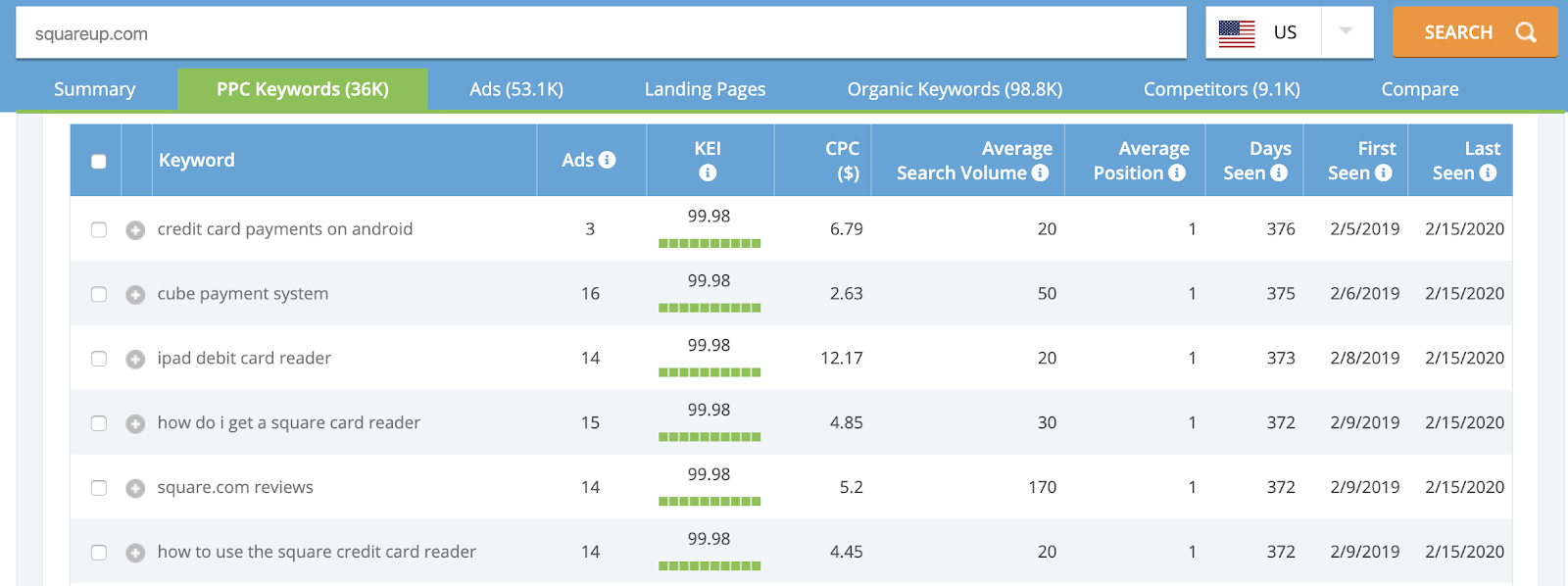
The Keyword Effectiveness Index (KEI) metric indicates whether a keyword is profitable, based on the duration that the competitor has been targeting the keyword and the date it was last seen. The fact that a keyword has been consistently targeted suggests that your competitor is seeing good returns, and therefore you might consider it as one for your own campaigns – providing it is relevant to your offer.
And within this dashboard, you can dig into each keyword to see which ad it triggers – allowing you to see the history of ad copy that has been used to attract clicks in the paid search results:
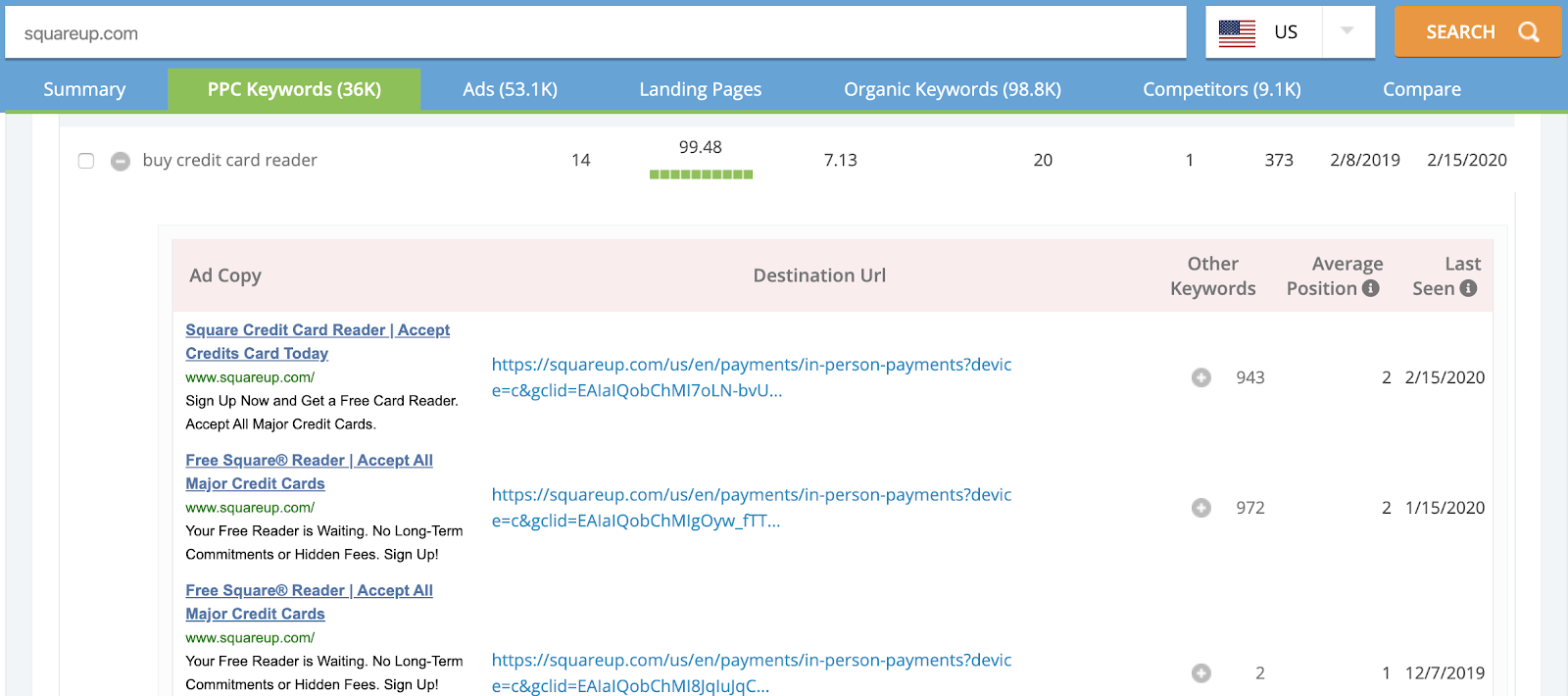
When you scroll across to the Ads tab on the top menu, you can see the full list of competitor PPC ads. If you check out the column “Group That Triggers The Ad” and expand the list, you’ll see how your competitor has structured their PPC ad groups – and whether they’ve gone with SKAGs or not.
In the case of our example, we can see that Square hasn’t. But if you’re active in this niche, you might want to take the most profitable keywords and set up SKAGs to target them with tightly-aligned ads and landing pages. This will help you compete in the PPC SERPs while keeping your CPC as low as possible.

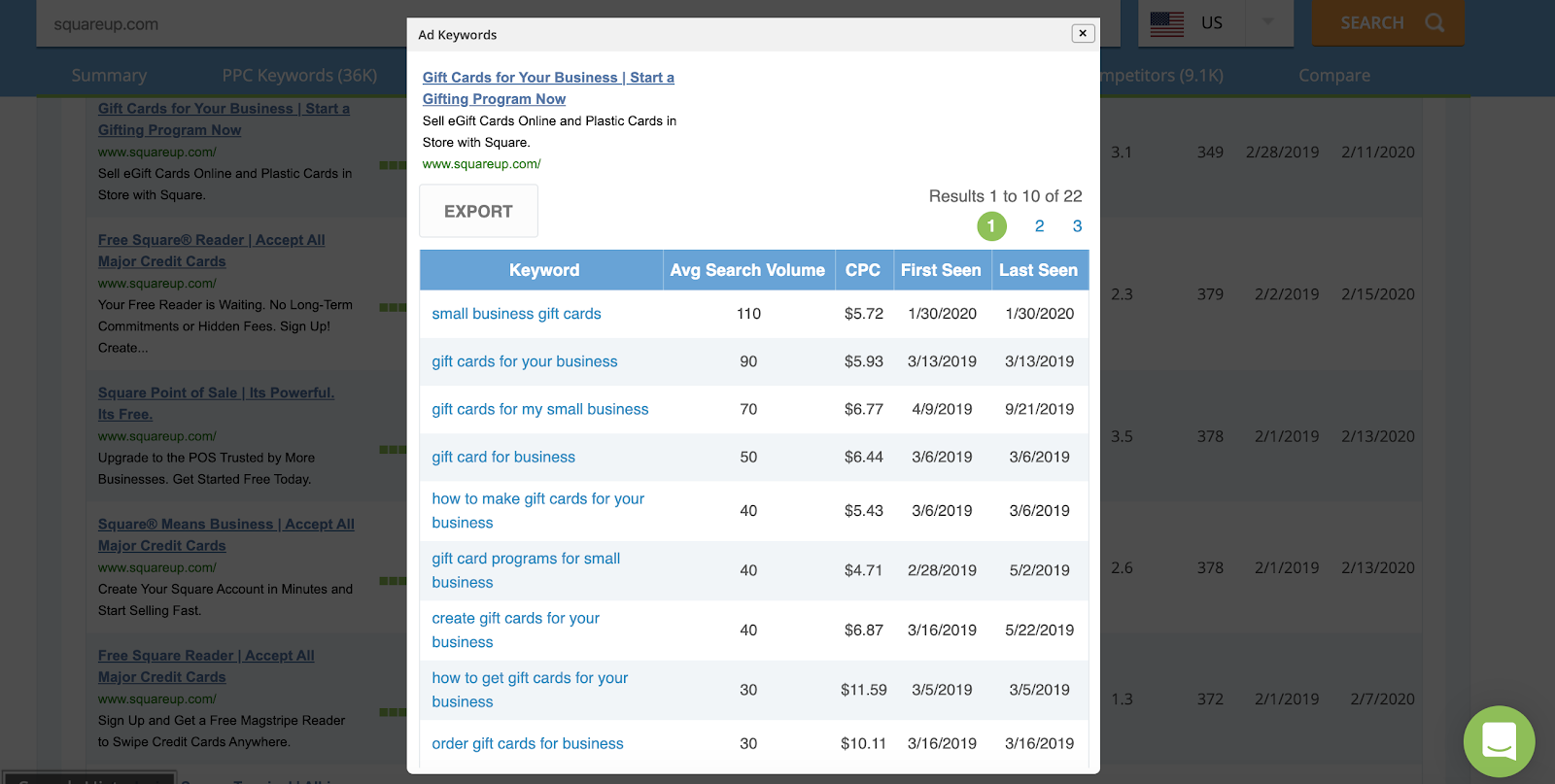
With the iSpionage Competitor Research feature, you can also search a keyword to reveal the best-performing advertisers (on a national level). You can either use this to dig into each competitor in that list, or run a specific competitor’s URL into the tool and see how they’ve set up their Google Ads campaigns. This informs your strategy and helps you set up campaigns in a way that makes sense.
The KEI metric helps you pick out what seem to the most profitable keywords for competitors, and this can inform the prioritization of your Single Keyword Ad Groups.
Sign up for a free iSpionage account to see competitor keywords, ad groups, ad copy, and landing pages. Receive 10 free competitor reports and 3 complimentary competitor alerts per day.
2. “Match Landing Pages to Your Ads and Target Keywords”
“A critical component of your Quality Score is the relevancy of your landing page to the keyword you’re targeting, which in turn directly impacts your average CPC. Therefore, it’s important to keep your landing page offer consistent with the problem (the keyword) and the promise (the ad text) – to lower your CPC as much as possible”, says Adam.
Of course, the landing page is where you’ll get the conversions that actually make your PPC campaign profitable. It’s your best chance to convince the user that you have the solution to their problem.
Your optimal PPC landing page design depends on your niche, offer, and audience. For example, a B2B software might drive users to a free trial, whereas an eCommerce store might land users straight onto a product or category page. Similarly, a recruiter might use their online jobs board to get users actively engaged, but an insurance provider may give the user a calculator form to figure out their rates. An emergency plumber might feature their phone number prominently, so the user can get in contact with a person immediately to explain their problem. Every business is different.
However, without exception, all effective landing pages are consistent with the source (i.e. with the ad copy promise) and they demonstrate a clear value proposition.
If you’re looking for inspiration when building PPC landing pages, check out the iSpionage PPC Landing Page Gallery. We’ve collected the best landing pages from various niches, including local services, tax, automobiles, health & rehab, insurance, education, finance, and more.
How to Track Competitor Landing Pages with Competitor Research & SEM Campaign Watch
iSpionage is the only PPC competitor research tool to include the full user journey within one single dashboard – including visual snapshots of each competitor landing page.
With the iSpionage Competitor Research feature, you can run competitor URLs to see how they align each stage of the process, without having to navigate away from the tool. In the example below, we see that SunRun maintains keyword focus throughout, despite actually offering an alternative product. Another thing to note – from a conversion perspective – is the use of an interactive calculator CTA.

With SEM Campaign Watch (paid subscription with risk-free 30 days), you can see how competitors align their landing pages to local SEO campaigns, too. And you can track a specific competitor who is targeting a particular set of keywords to monitor the outcomes of their A/B tests for ads and landing pages.
This insight helps you understand which messages work best, which can then inform your own strategy for creating an effective PPC user journey.
To learn more about analyzing landing pages in your niche, read our article about using iSpionage to find the most profitable competitor landing pages.
3. “Continually Test Multiple Ad Variations to Improve CTR”
“If you can improve click-through rate (CTR), this will contribute to a better Quality Score. And a higher Quality Score will help you to lower your CPC. Therefore, it is vital to optimize your CTR in the search for a reduced CPC on your ad campaign(s). To achieve this, you need to adopt a continuous testing mindset.”
What does this mean, exactly? Well, according to Adam, this means “never being totally satisfied with the performance of any ad.” You can test different offers, ad copy, and callout copy – and try extensions such as sitelink extensions, ratings extensions, and call extensions, to move the needle on CTRs.
Quite simply, PPC marketers should play the game of trying to beat their previous best CTR with continuous tests and ad variations. And there’s no better advantage when testing than to know what the competition is up to, because their tests can do some of the learning for you…
How to Track Competitor A/B Tests for Ads
As we already mentioned, SEM Campaign Watch allows you to track the A/B tests of landing pages when you follow specific competitors and keywords over time, and you can also do this for competitor ads:
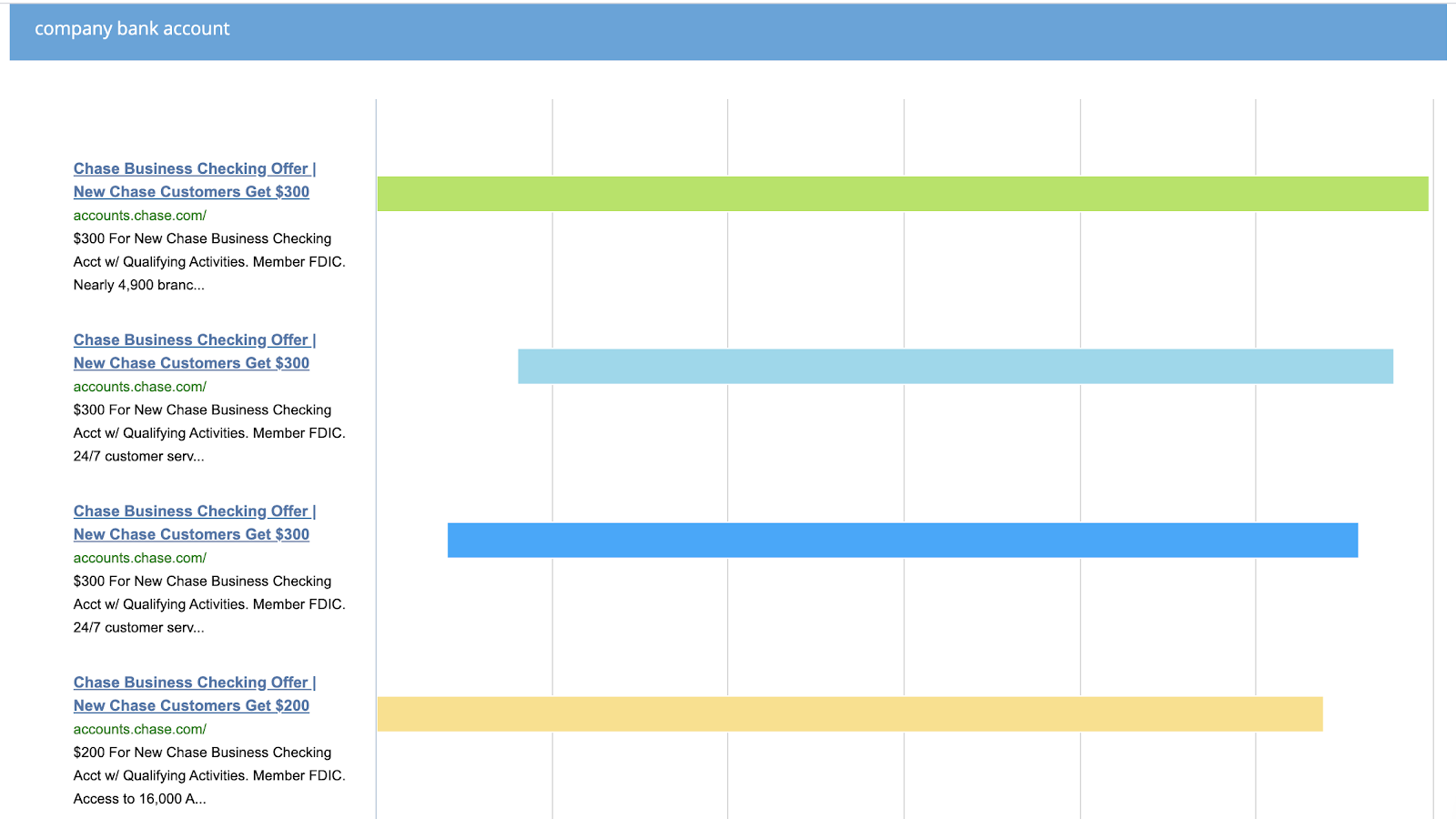
We can see in the screenshot above that Chase is testing various ads for the “company bank account” keyword, and these tests are running concurrently. When we look at these variations, we see that Chase is testing different joining fees ($200 vs. $300) and different customer service benefits – e.g. 4,900 branches vs. 24/7 customer service.
iSpionage will track which variation wins (i.e. which one is most profitable), and this can inform your own testing process if you’re targeting the same product keyword.
Also, our Competitor Research feature (available on a free account) can provide insight into competitor ad variations. When you run a competitor URL through the tool and navigate to the PPC Keywords tab, you can expand the list of keywords to see which ads are triggered by it.
By looking at the Last Seen column, you can determine if and/or when an older ad was beaten by a newer one in an A/B test:

If you’re researching direct competitors who are targeting the same commercial keywords, these insights allow you to skip the early learning process and start from stronger foundations with your own A/B tests.
In the example above (TransferWise), we can see that the most recent variation has snappier copy, featuring three key benefits in the headline and a much shorter description text.
Sign up for a free iSpionage account to see competitor ads, keywords, and landing pages. Receive 10 free competitor reports and 3 complimentary competitor alerts per day. Our A/B test monitoring is available via paid subscription, and with our 30-day money-back guarantee you can try it without risk.
Key Takeaways: How to Get a Lower CPC
In Adam’s view, there is no single magic bullet for achieving a low cost-per-click on Google Ads. Instead, our focus should be on improving Quality Score by optimizing the ad relevance and landing page relevance, and by continuously testing different variations to move the needle on CTR.
According to Adam, there are plenty of tactics that could feasibly contribute to a lower CPC, and these approaches are all part of the continuous testing mindset:
“For example, you can – and should – optimize your geotargeting and scheduling to zero-in on the locations and times where you can achieve optimal CPC. You can try Sitelink Extensions and test different callouts – and even try lower bids after boosting your Quality Score. It’s all about finding the most influential factors for your audience and whittling down the waste as much as possible”, he says.
By using iSpionage, you can access competitor data to guide you in your quest to reduce CPC. You can discover the most profitable keywords, and see how leading competitors are structuring their Google Ad accounts. And by tracking the A/B tests of ads and landing pages, you can learn from competitor experiments and start testing your PPC campaigns one step ahead of the rest.
Sign up for a free iSpionage account to see competitor keywords, ad groups, ad copy, and landing pages. Receive 10 free competitor reports and 3 complimentary competitor alerts per day.
Our Campaign Watch functionality is available via paid subscription, and with our 30-day money-back guarantee you can try it without risk.
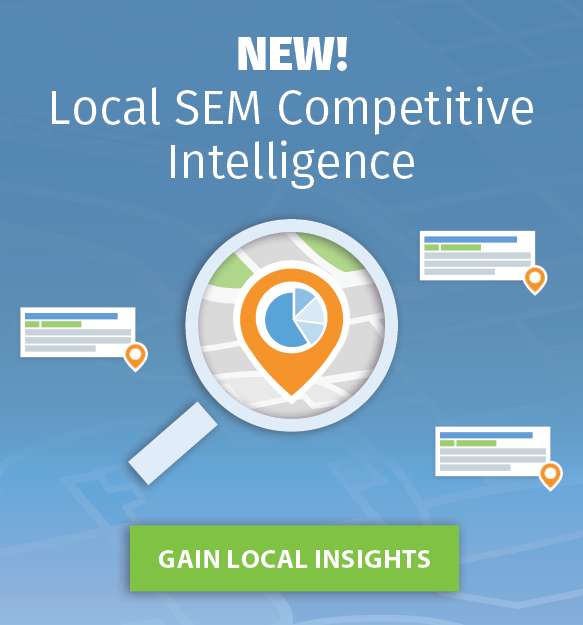










Comments are closed.